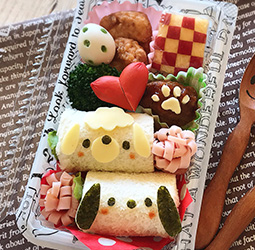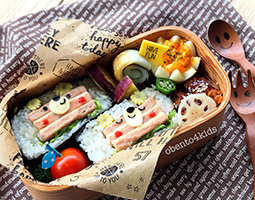INDEX
- English
- 日本語

Typically cute and nutritious kyaraben - English
- 日本語

Maruo Tomomi leads a kyaraben workshop for children



Typically cute and nutritious kyaraben
June 2020
Kyaraben: Bringing Smiles to Children’s Faces

Kyaraben, or “character bento,” are boxed lunches that have been decorated to resemble popular fictional characters and other creatures or things. Packing a cute lunch for a child is said to strengthen family bonds and prevent picky eating.

“Character bento,” known as kyaraben for short, are boxed lunches containing food that has been arranged and decorated to resemble anime or game characters, mascots, teddy bears and other such cute things. Children will often eat food they don’t normally like if it has been presented in a fun, artistic way.
Maruo Tomomi is a food designer who shares her expertise in making kyaraben through food events and books. Known as the “Kyarabenist,” Maruo believes that “kyaraben are tools to communicate with children.”
“Creating a boxed lunch based on what children like and are interested in sends a message that says, ‘I care about you.’ For example, I recommend making a kyaraben based on a character or an impressive scene from a movie you watched together with your child.”
Maruo gave her eldest son a boxed lunch four days a week when he began going to kindergarten in 2004, and this was when she began making kyaraben. At that time, kyaraben were not common, but wanting her four-year-old son to be able to enjoy his meal time even at kindergarten, she went about making them through trial and error.
“I looked forward to my child happily coming back home with his empty lunch box,” she says.
Soon, as she became able to create kyaraben just how she imagined them, she began to get requests from mothers of her son’s friends who had seen her beautiful creations, asking her to teach them how to make kyaraben. So she started “the Obento4Kids kyaraben workshop,” holding classes irregularly whenever she received requests through her blog. Nowadays, she receives many requests to hold kyaraben-making events from corporations and local governments who have seen her blog.



Three-dimensional kyaraben are very popular lately, designed so that the character seems to jump out from the lunch box as the lid is opened. For example, animal ears, paws, noses, and other three-dimensional parts are expressed by using fried pasta and then fixed in place by sticking it in other ingredients. When it’s time to eat, the fried pasta will have become soft, taking in some of the moisture from the other ingredients, so there’s no worry of injuring the inside of the mouth as it mixes with the other ingredients.
Dried seaweed, cheese, ham and other ingredients are used for the patterns, and the design is stuck together and fixed with mayonnaise. It’s important to pack the food in so it is low enough that the ingredients don’t touch the lid and thus ruin the design.
Maruo states that, of course, in addition to the appearance, the most important thing is taste.
“I choose ingredients that taste good together, such as kombu seaweed and cheese with white rice.”
She is also careful to finish a kyaraben quickly while the ingredients are still fresh, keeping hygiene in mind. It’s important, she says, to be simple with the design and not worry so much about details, with preparations taking less than an hour at most.
Lately, interest in Japan’s kyaraben is increasing, with kyaraben workshops even included in tours of Japan for visitors from abroad. Both online and through other ways, Maruo hopes to support people who want to learn how to make kyaraben for their children and for personal enjoyment, too.

